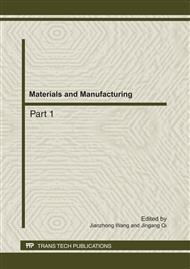[1]
Huang Tian, Wang Jinsong, Derek G C. et al: Chinese journal of Mechanical Engineering Vol. 38, p.1.
Google Scholar
[2]
H. Zhuang, O. Masory, J. Yan, in: Kinematic Calibration of Steward Platform Using Pose Measurements Obtained by Single Theodolite. Proceedings of IEEE/RSJ International Conference on Intelligent Robotics and Systems, Pittsburg(1995).
DOI: 10.1109/iros.1995.526237
Google Scholar
[3]
P. Vischer, R. Clavel: Robotics Vol. 16 (1998), pp.207-218.
Google Scholar
[4]
Gao Meng, Li Tiemin, Zheng haojun, et al: Journal of Tsinghua University Vol. 40 (2004), p.1013.
Google Scholar
[5]
S. Besnard, W. Khalil, in: Calibration of Parallel Robot Using Two Inclinometers. Proceedings of IEEE International Conference on Robotics and Automation, Detroit (1999).
DOI: 10.1109/robot.1999.770363
Google Scholar
[6]
D. Daney, L. Z. Emiris, in: Robust Parallel Robot Calibration with Partial Information Proceedings of IEEE International Conference on Robotics and Automation, Seoul (2001).
DOI: 10.1109/robot.2001.933121
Google Scholar
[7]
T. Ropponen, T. Aron, in: Accuracy Analysis of a Modified Steward Platform Manipulator. IEEE International Conference on Robotics and Automation, Automation, Nagoya, Aichi, Japan. New York: IEEE(1995).
DOI: 10.1109/robot.1995.525336
Google Scholar
[8]
Patel. A. J.: Annals of the CIRP Vol. 46(1997), p.287.
Google Scholar
[9]
Soons. J. A: Laser Metrology and Machine Performance (1997), p.346.
Google Scholar
[10]
Wang Jian, Masory O. : IEEE international Conference on Robotics and Automation, May 2-7, 1993, Atlanta, Georgia, USA. New York: IEEE (1995).
Google Scholar
[11]
Gao Meng, Li Tiemin, Zheng Haojun, et al: Journal of Tsinghua University Vol. 43 (2003), p.617620.
Google Scholar
[12]
Wang Jinsong, Bai Jiewen, Gao Meng, et al: Journal of Tsinghua University Vol. 42(2002), p.658.
Google Scholar
[13]
Shan Peng, Xie Liyang, Tian Wanlu, et al: Chinese Journal of Mechanical Engineering Vol. 46 (2010), p.186.
Google Scholar
[14]
Huang Zhen: Parallel Robot Mechanism and Control (Machinery Industry Press, Beijing 1997).
Google Scholar
[15]
Xue Jiaqing. Optimization Theory and Method. (Metallurgical Industry Press, Beijing 1983).
Google Scholar


